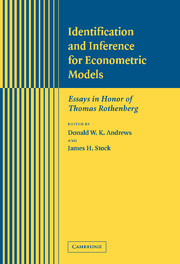Book contents
- Frontmatter
- Contents
- List of Contributors
- Preface
- Part I Identification and Efficient Estimation
- 1 Incredible Structural Inference
- 2 Structural Equation Models in Human Behavior Genetics
- 3 Unobserved Heterogeneity and Estimation of Average Partial Effects
- 4 On Specifying Graphical Models for Causation and the Identification Problem
- 5 Testing for Weak Instruments in Linear IV Regression
- 6 Asymptotic Distributions of Instrumental Variables Statistics with Many Instruments
- 7 Identifying a Source of Financial Volatility
- Part II Asymptotic Approximations
- Part III Inference Involving Potentially Nonstationary Time Series
- Part IV Nonparametric and Semiparametric Inference
6 - Asymptotic Distributions of Instrumental Variables Statistics with Many Instruments
Published online by Cambridge University Press: 24 February 2010
- Frontmatter
- Contents
- List of Contributors
- Preface
- Part I Identification and Efficient Estimation
- 1 Incredible Structural Inference
- 2 Structural Equation Models in Human Behavior Genetics
- 3 Unobserved Heterogeneity and Estimation of Average Partial Effects
- 4 On Specifying Graphical Models for Causation and the Identification Problem
- 5 Testing for Weak Instruments in Linear IV Regression
- 6 Asymptotic Distributions of Instrumental Variables Statistics with Many Instruments
- 7 Identifying a Source of Financial Volatility
- Part II Asymptotic Approximations
- Part III Inference Involving Potentially Nonstationary Time Series
- Part IV Nonparametric and Semiparametric Inference
Summary
ABSTRACT
This paper extends Staiger and Stock's (1997) weak instrument asymptotic approximations to the case of many weak instruments by modeling the number of instruments as increasing slowly with the number of observations. It is shown that the resulting “many weak instrument” approximations can be calculated sequentially by letting first the sample size, and then the number of instruments, tend to infinity. The resulting distributions are given for k-class estimators and test statistics.
NTRODUCTION
Most of the literature on the distribution of statistics in instrumental variables (IV) regression assumes, either implicitly or explicitly, that the number of instruments (K2) is small relative to the number of observations (T); see Rothenberg's (1984) survey of Edgeworth approximations to the distributions of IV statistics. In some applications, however, the number of instruments can be large; for example, Angrist and Krueger (1991) had 178 instruments in one of their specifications. Sargan (1975), Kunitomo (1980), and Morimune (1983) provided early asymptotic treatments of many instruments. More recently, Bekker (1994) obtained first-order distributions of various IV estimators under the assumptions that K2 → ∞, T → ∞, and K2/T → c, 0 ≤ c < 1, when the so-called concentration parameter (μ2) is proportional to the sample size and the errors are Gaussian. Chao and Swanson (2002) have explored the consistency of IV estimators with weak instruments when the number of instruments is large, in the sense that K2 is also modeled as increasing to infinity, but more slowly than T.
This paper continues this line of research on the asymptotic distribution of IV estimators when there are many instruments.
Information
- Type
- Chapter
- Information
- Identification and Inference for Econometric ModelsEssays in Honor of Thomas Rothenberg, pp. 109 - 120Publisher: Cambridge University PressPrint publication year: 2005
Accessibility standard: Unknown
Why this information is here
This section outlines the accessibility features of this content - including support for screen readers, full keyboard navigation and high-contrast display options. This may not be relevant for you.Accessibility Information
- 375
- Cited by
